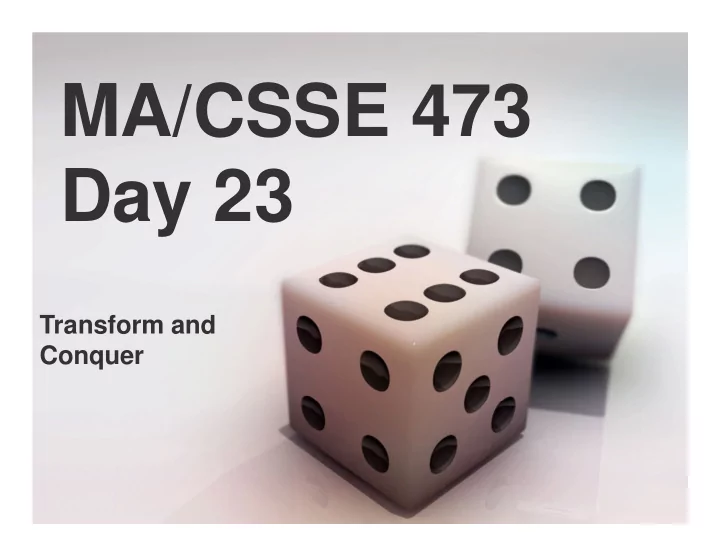

MA/CSSE 473 Day 23 Transform and Conquer
MA/CSSE 473 Day 23 • Scores on HW 7 were very high (except for 5 students who didn't do it at all). More perfect scores on this one than any previous assignment. Good job! • HW 9 is due tomorrow – with a "late day" that extends until Friday at noon. • HW 10 due next Tuesday, Oct 19 • ConvexHull implementation due Thursday, Oct 21 • HW 11 due Friday, Oct 22. It is smaller than most assignments. • HW 12 due Tuesday, Oct 26. • Take-home exam available Oct 29 (Friday) at 9:55 AM, due Nov 1 (Monday) at 8 AM. • Student Questions • Transform and conquer – Many of the examples should be review.
Transform and Conquer Algorithms • Transform a problem to a simpler instance of the same problem – instance simplification • Transformation to a different representation of the same instance – representation change • Transformation to an instance of a different problem that we know how to solve – problem reduction Q1
Presorting an Array • The following problems are simplified by pre- sorting the array: – Search (can do Binary or Interpolation search) – Determine whether the array contains duplicates – Find the mode of the elements of the array • The most frequently-occurring element – A related problem: Anagrams • In a large collection of words, find words that are anagrams of each other • How can pre-sorting help? • Sort the letters of each word – Interval union problem from early part of PLC Q2-3
Gaussian Elimination (review of MA221) • Solve a system of n linear equations in n unknowns – Represent the system by an augmented coefficient matrix – Transform the matrix to triangular matrix by a combination of the following solution-preserving elementary operations: • exchange two rows • multiply a row by a nonzero constant • replace a row by that row plus or minus a constant multiple of a different row – Look at the algorithm and analysis on pp 207-208; if you can't understand them, ask at some point. • Hopefully you saw this in your D.E. class. – Ѳ(n 3 ) Q4-5
Other Applications of G.E. • Matrix inverse – Augment a square matrix by the identity matrix – Perform elementary operations until the original matrix is the identity. – The "augmented part" will be the inverse – More details and an example at http://en.wikipedia.org/wiki/Gauss- Jordan_elimination
Other Applications of G.E. • Determinant calculation – Calculation of the determinant of a triangular matrix is easy • What effect does each of the elementary operations have on the determinant? – exchange two rows – multiply a row by a nonzero constant – replace a row by that row plus or minus a constant multiple of a different row • Do these operations until you get a triangular matrix • Keep track of the operations' cumulative effect on the determinant
LU Decomposition • This can speed up all three applications of Gaussian Elimination • Write the matrix A as a product of a Lower Triangular matrix L and an upper Triangular matrix � � U. 25 5 1 � � [ ] A = 64 8 1 � � • Example: � � � � 144 12 1 � � � � 1 0 0 25 5 1 � � � � [ ] [ ] = 2 . 56 1 0 = 0 − 4 . 8 − 1 . 56 L U � � � � � � � � � � � � 5 . 76 3 . 5 1 0 0 0 . 7 Q6
Balanced Search Trees • Why do we introduce the idea of Binary Search Trees? – i.e., why are array lists or linked lists not good enough? • What is the problem if we don't make sure Binary Search Trees are kept balanced after insert or delete? • AVL Trees (height balanced) • Review of why we know that the max height of an AVL tree is Ѳ(log N). • Review the balancing algorithms after insertion, deletion.
• Named for authors of original paper, A delson- V elskii and L andis (1962). • An AVL tree is a height-balanced Binary Search Tree. • A BST T is height balanced if T is empty, or if – | height( T L ) - height( T R ) | ≤ 1, and – T L and T R are both height-balanced. • Show: Maximum height of an AVL tree with N nodes is Θ (log N). • How do we maintain balance after insertion? • Exercise: Given a pointer to the root of an AVL tree with N nodes, find the height of the tree in log N time. • Details on balance codes and various rotations are in the CSSE 230 slides that are linked from the schedule page. Q7-11
Recommend
More recommend